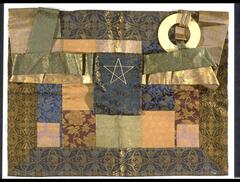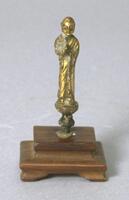31 UMMA Objects
31 UMMA Objects

Yokoi Kinkoku (Japanese (culture or style))
Portrait of the Poet 'Basho'
1767 – 1832
Museum purchase made possible by the Margaret Watson Parker Art Collection Fund
1968/2.22

Pierre Bonnard (French (culture or style))
Affiche de La Revue Blanche
1894
Museum Purchase
1959/2.97

Japanese (Japanese (culture or style))
Portrait of a Monk (Hônen?): Pilgrimage Souvenir from Hôshôji, Kodairao ?) Village, Wakayama Prefecture
19th century
Museum purchase for the Paul Leroy Grigaut Memorial Collection
1971/2.11

Japanese (Japanese (culture or style))
Tsuba (sword guard) with design of Kanzan (Chinese, Han Shan) and Jittoku (Chinese, Shihde), two Zen eccentrics
1700 – 1732
Gift of Mr. and Mrs. Robert T. Weston
1978/2.5

Japanese (Japanese (culture or style))
Buddhist Surplice
1950s
Gift of Ulrich and Sarah Straus, in memory of H. Alexander Straus
1998/1.144

Chinese (Chinese (culture or style))
Standing figure of a monk, in anjalî mudrâ
7th century
Museum purchase for the James Marshall Plumer Memorial Collection
1961/2.72
Japanese (Japanese (culture or style))
Kesa (monk's surplice) Fragment
17th century
Gift of Mr. and Mrs. Stephen H. Spurr
2003/2.21

Thai
Phra Malai (The Monk)
1800 – 1932
Gift of Doris Duke's Southeast Asian Art Collection
2005/1.453

Artist Unknown, India, Rajasthan, Sirohi School
Digambara Jain manuscript page: Jina venerated by a community of laymen
18th century
Gift of Dr. and Mrs. Leo S. Figiel and Dr. and Mrs. Steven J. Figiel.
1975/2.169
![Two distinct registers divide a page in half. At the top, a yellow-orange colored nude jina sits in lotus position upon a three tiered throne [a patterned blue level at the bottom on feet, with an orange section with gold and red decoration and a green level at the top with gold vertical stripes]. He sits against a red background adorned with a pattern of three white dots. The background takes the shape of an elegant cusped arch with a green and white pattern along its outside with a gold pattern at its sides. To the right of the seated figure a nude Digambara monk sits with his legs folded and one knee up on a less elaborate throne with a lota or pot at the corner and a crossed bookstand to the side holding a book with some devanagari writing on it. He raises his right arm and holds his left to his ear.<br />
Placed under a band of curving yellow stripes, the bottom register represents animals in a landscape. At the bottom are clumps of grass with four stylized mountain forms in blue at the right. Above the Two distinct registers divide a page in half. At the top, a yellow-orange colored nude jina sits in lotus position upon a three tiered throne [a patterned blue level at the bottom on feet, with an orange section with gold and red decoration and a green level at the top with gold vertical stripes]. He sits against a red background adorned with a pattern of three white dots. The background takes the shape of an elegant cusped arch with a green and white pattern along its outside with a gold pattern at its sides. To the right of the seated figure a nude Digambara monk sits with his legs folded and one knee up on a less elaborate throne with a lota or pot at the corner and a crossed bookstand to the side holding a book with some devanagari writing on it. He raises his right arm and holds his left to his ear.<br />
Placed under a band of curving yellow stripes, the bottom register represents animals in a landscape. At the bottom are clumps of grass with four stylized mountain forms in blue at the right. Above the](/media/W1siZiIsIjIwMjIvMDUvMjUvMXoxZ2ZnNHN6Zl9kZWZhdWx0LmpwZyJdLFsicCIsInRodW1iIiwiMjQweDIwMCJdXQ?sha=54d3764ea6247e3b)
Artist Unknown, India, Rajasthan, Sirohi School
Jain Tirthankara and a monk with animal forest scene, no. 12 from a Digambara series
18th century
Gift of Dr. and Mrs. Leo S. Figiel and Dr. and Mrs. Steven J. Figiel
1975/2.178

Thai
Monk (attendant figure at a Buddhist altar)
1800 – 1932
Gift of the Estate of Margaret E. Tracy
1978/2.48
Loading…

